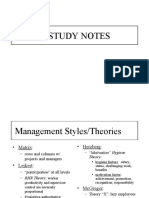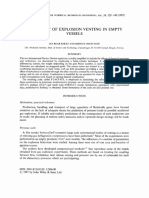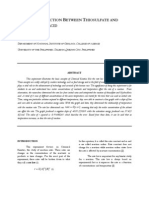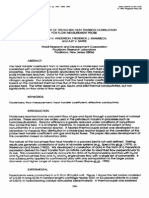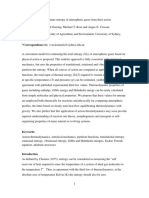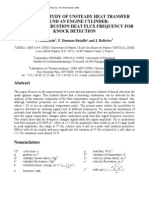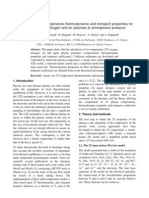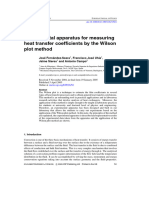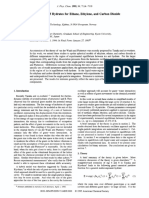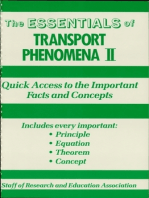Cool Flames
Cool Flames
Uploaded by
Qasim IsmailCopyright:
Available Formats
Cool Flames
Cool Flames
Uploaded by
Qasim IsmailOriginal Title
Copyright
Available Formats
Share this document
Did you find this document useful?
Is this content inappropriate?
Copyright:
Available Formats
Cool Flames
Cool Flames
Uploaded by
Qasim IsmailCopyright:
Available Formats
Limit-Cycle Behaviour in a Model Chemical Reaction: The Sal'nikov Thermokinetic Oscillator
Author(s): Lawrence K. Forbes
Source: Proceedings: Mathematical and Physical Sciences, Vol. 430, No. 1880 (Sep. 8, 1990), pp.
641-651
Published by: The Royal Society
Stable URL: http://www.jstor.org/stable/79959
Accessed: 16-04-2015 12:13 UTC
Your use of the JSTOR archive indicates your acceptance of the Terms & Conditions of Use, available at
http://www.jstor.org/page/info/about/policies/terms.jsp
JSTOR is a not-for-profit service that helps scholars, researchers, and students discover, use, and build upon a wide range of content
in a trusted digital archive. We use information technology and tools to increase productivity and facilitate new forms of scholarship.
For more information about JSTOR, please contact support@jstor.org.
The Royal Society is collaborating with JSTOR to digitize, preserve and extend access to Proceedings: Mathematical and
Physical Sciences.
http://www.jstor.org
This content downloaded from 131.227.107.99 on Thu, 16 Apr 2015 12:13:33 UTC
All use subject to JSTOR Terms and Conditions
Limit-cycle behaviour in a model chemical
reaction: the Sal'nikov thermokinetic oscillator
BY LAWRENCE
K. FORBES
Department of Mathematics, University of Queensland, St Lucia,
Queensland 4067, Australia
The Sal'nikov thermokinetic oscillator is a model chemical reaction consisting of a
two-stage decay of some chemical species. The first stage is a straightforward firstorder decay process at constant temperature, but the second stage is exothermic, and
is assumed to be governed by Arrhenius kinetics. When the containing vessel is wellstirred, the kinetic rate equation for the reaction along with an equation expressing
conservation of energy leads to a system of two ordinary differential equations
describing the behaviour of the process. The equations are coupled and highly
nonlinear, and their solution gives the temperature inside the vessel and the
concentration of the intermediate chemical species. Under certain circumstances,
sustained periodic oscillations in these two quantities are possible.
In this paper, I give a rigorous proof that these remarkable oscillations are not
possible for certain combinations of the defining physical parameters. A numerical
solution technique for obtaining periodic oscillations in the system is then presented;
the method gives results of great accuracy, it automatically determines the stability
of the solution, and is capable of computing unstable periodic orbits. Results of
extensive numerical investigation are presented, and the occurrence of unstable limit
cycles and multiple solutions is discussed in detail.
1. Introduction and problem formulation
In recent years there has been a great deal of interest in chemical reactions in which
persistent oscillations are possible in the concentrations of certain intermediate
species. Perhaps the most famous of these is the Belousov-Zhabotinskii reaction, a
complex sequence of elementary reactions involving malonic acid, cerium ammonium
nitrate and sodium bromate. The process is actually observable in the laboratory as
a sustained periodic alternation between the colours red and blue, when a suitable
chemical indicator is added to the solution. This reaction is envisaged as being
essentially isothermal, and is discussed in detail in the book by Tyson (1976).
Isothermal reactions capable of producing oscillatory behaviour are believed to be of
significance in biology, as discussed by Grasman (1987, p. 8), where perhaps they
provide a mechanism for the processes of ageing or the regular beat of the heart.
Oscillatory behaviour is also possible in reactions for which isothermal conditions
do not apply. Sal'nikov (1949) proposed a simple model reaction consisting of a twostage decay of some precursor species P, through an intermediate chemical A, to a
final product B. The reaction may be written
ko
P-A,
Proc. R. Soc. Lond. A (1990) 430, 641-651
k1
AB.
Printed in Great Britain
641
This content downloaded from 131.227.107.99 on Thu, 16 Apr 2015 12:13:33 UTC
All use subject to JSTOR Terms and Conditions
(1.1)
L. K. Forbes
642
The first stage is assumed to be isothermal, but the second is associated with the
production of heat, so that the rate 'constant' k1 is in fact dependent upon the
temperature T. It will be assumed here that the dependence is in accordance with the
Arrhenius law
kI = kaexp [E/R (l/Tae-1/T)]
(1.2)
in which the quantities ka, E, R and Ta are all constants. The purpose of this paper
is to investigate the oscillatory behaviour of this reaction, invoking the 'poolchemical' approximation for simplicity, under which it is assumed that the amount
of the precursor species P is in such vast excess that it may be regarded as
inexhaustible.
Although the model reaction described by equations (I.1) and(1.2) is an idealization
of the undoubtedly more complex processes which occur in thermal combustion, the
types of behaviour it predicts can be observed experimentally. In the comprehensive
article by Griffiths (1986), oscillatory behaviour is described in an exothermic
reaction involving acetaldehyde and oxygen. Cool-flame oscillations are observed in
which the amplitude of oscillation is relatively small, along with oscillatory
behaviour of a more violent type where there are large excursions in temperature
accompanied by flashes of light. Similar experimental observations are also reported
by Griffiths & Scott (1987). A comprehensive review of oscillatory behaviour in both
isothermal and non-isothermal model reactions is given by Gray (1988) and includes
further experimental observation of non-isothermal oscillatory behaviour, here
obtained in the decomposition of di-tert-butyl peroxide admitted at constant rate
into a closed vessel. Gray & Griffiths (1989) present a detailed account of an
experiment which successfully mimics the conditions assumed in the Sal'nikov
oscillator.
A mathematical description of the progress of reaction (1.1) is given simply by the
rate equation
da/dt = kop- ka,
(1.3)
where the symbols a, b and p denote the molar concentrations of chemicals A, B and
P, respectively. Time is denoted by the symbol t. According to the pool-chemical
approximation described above, the concentration p of the precursor species is taken
to be constant.
Suppose that the reaction takes place in a vessel of volume V which has surface
area S. The contents of the vessel are well stirred, so that conditions are uniform
throughout. The physical requirement that the rate of energy production within V
should equal the rate at which heat energy enters through surface S plus the heat
generated internally through the exothermic phase of the reaction gives rise to the
conservation law
dt pcTdV=-
q.nd8+S
QdV,
(1.4)
in which p and c are respectively the density and heat capacity of the mixture, q is
a surface heat flux vector, n is the outward normal to surface S and Q denotes the
heat energy generated per unit volume per unit time by the second stage of the
reaction. It will be assumed here that Q is given by the formula Q = Q1k1 a, where
the exothermicity coefficient Q1 is a constant, having dimensions of energy per unit
concentration per unit volume.
According to Newton's law of cooling, the heat flux vector q at the surface of the
Proc. R. Soc. Lond. A (1990)
This content downloaded from 131.227.107.99 on Thu, 16 Apr 2015 12:13:33 UTC
All use subject to JSTOR Terms and Conditions
Limit cycles in the Sal'nikov oscillator
643
0.25 _u.uu
-' 0.005
-:\
,
0.02
/^
\/, '-
0.15 -1
Ii
`?\
Y;\ V~
: j/
05
0.05
,'
0.05
-
^~_'~ _.
'
/
/
0.05
0.15
0.25
I/
Figure 1. The location in the ,u, e parameterspace of the Hopf bifurcationpoints, for the four
values of the parameterK= 0.002, 0.005, 0.02 and 0.05.
vessel is determined by the temperature T inside the container and the ambient
temperature Ta outside, from the relation
q n = H(T-T,),
(1.5)
in which H is a heat transfer coefficient, with dimensions of energy per unit
temperature per unit time per unit surface area. Equation (1.5) is substituted into
(1.4) and the volume and surface integrals are evaluated to give the energyconservation equation
pcVdT/dt = -HS(T-
T) + Q1kI aV.
(1.6)
Equation (1.6) is highly nonlinear, since the rate constant kI is given by the
Arrhenius law (1.2).
Equations (1.2), (1.3) and (1.6) may be simplified somewhat by the choice of
appropriate dimensionless variables. I follow Gray et al. (1988) and define
HS
~=tpcV
VQi E
0'THSRT2
(T
ET
T
2)RT2
Thus T, a and 0 are respectively the dimensionless time, concentration of the
intermediate product and temperature rise above ambient. In these new variables,
the governing equations may be written
doc/dr = ut-KO exp (0/(1 + 0)),
|
dO/dT = aexp (0/(1 +e))-O,
(1.7)
where, again following Gray et al. (1988), I have defined three dimensionless
groupings of parameters
RT,
E '
_pcVka,
HS'
K(ko VQ,
HST
Proc. R. Soc. Lond. A (1990)
This content downloaded from 131.227.107.99 on Thu, 16 Apr 2015 12:13:33 UTC
All use subject to JSTOR Terms and Conditions
L. K. Forbes
644
Solutions to the model equations (1.7) have been investigated by Gray et al. (1988)
for the case e = 0, in a rather complete analysis which also includes the effect of a
slow consumption of the precursor chemical P. They identified a small region of the
#,K parameter space in which sustained periodic oscillations could occur. Their
analysis shows that the periodic oscillation, when it occurs, is unique and stable to
small perturbations when e = 0. Their results also suggest that oscillations are not
possible when K/, > I; we give a formal proof of this result in ?2.
The full system of equations (1.7) with e arbitrary has been analysed by Kay &
Scott (1988) and also by Gray & Roberts (1988b). These authors found a small region
of the parameter space in which the oscillations could become unstable through a
subcritical Hopf bifurcation. In these regions, phase-plane analysis indicates that
two periodic orbits must exist, one of which is stable and the other unstable. In ?4
I discuss this case in detail, and present numerical solutions of great accuracy for
both the stable and unstable limit cycles. In addition, I give a rigorous proof in ?2
of the observation by Kay & Scott that periodic oscillations are not possible when
>
2. Qualitative
results
It is instructive to consider the behaviour of the equilibrium points of equations
(1.7), where the derivatives with respect to time are both zero. The unique
equilibrium point is (ae, Oe), where
O/e
I/Kexp(-
/((K + 6u)),
0e =
//K.
(2.1)
Stability may be determined by linearizing equations (1.7) about the equilibrium
point, and seeking solutions proportional to the exponential function exp (AT). It is
then found that the multiplier A becomes purely imaginary whenever
K exp (//(K
+ eU)) = K/I (K + e)2
- 1.
(2.2)
According to the Hopf theorem, equation (2.2) gives the values of the parameters
at which periodic solutions are created. When K and e are fixed, it is possible to show
that there are two solutions to equation (2.2) provided that e ..' Let us denote the
smaller root of this equation by t = ,u_ and the larger root by ut = ,+; then, for a fixed
value of K, the two Hopf bifurcation points u_ and /, will vary as functions of e.
Eventually, as e is increased, the two bifurcation points u_ and a+ will move together
and finally coalesce. At this point, the periodic solution which exists in the interval
,a_ < I < u+ will be extinguished in an H21 degeneracy of type A (using the notation
of Gray & Roberts (1988a)). For larger values of e, periodic oscillations are then not
possible at this value of K. For a given value of K, the region in the /u,e parameter
plane within which oscillatory solutions are possible is bounded by a loop of height
e < . Four such regions are shown in figure 1, for K = 0.002, 0.005, 0.02 and 0.05. By
careful application of the Hopf theorem, Kay & Scott (1988) and Gray & Roberts
(1988b) have shown that the Hopf bifurcation at the smaller root au= /_ is always
supercritical, emerging as a stable orbit surrounding an unstable equilibrium point.
However, the Hopf bifurcation at the larger root a+ may change from supercritical
to subcritical, in an H31 degeneracy (again, see Gray & Roberts (1988a) for an
explanation of this notation). In this case, the situation exists in which a stable
equilibrium point is surrounded by two limit cycles, the inner one unstable and the
outer one stable.
Proc. R. Soc. Lond. A (1990)
This content downloaded from 131.227.107.99 on Thu, 16 Apr 2015 12:13:33 UTC
All use subject to JSTOR Terms and Conditions
Limit cycles in the Sal'nikov oscillator
645
I conclude this section by proving rigorously that periodic solutions are not
possible in the regions of the parameter space anticipated by Gray et al. (1988) and
Kay & Scott (1988).
Theorem. The Sal'nikov thermokinetic oscillator problem defined by equations (1.7)
has no periodic solutions (1) when K// > 1, (2) when e > 1, for all t and K.
Proof. To prove the absence of periodic solutions to equations (1.7) for certain
values of the parameters, it is necessary to establish that closed orbits are not
possible in the phase plane in these cases. We do this with the aid of Dulac's theorem
(a generalization of Bendixson's negative criterion; see Jordan & Smith (1979, pp. 84
and 93)). Periodic solutions are not a possibility if there exists a function B(a, 0) such
that the quantity
{BLt-Ka
exP(l0)1}
+a
a{B exp(
0) 1
(2.3)
is non-zero and does not change sign.
Consider the choice of Dulac function
B(c, 6) = exp [-m((c/K + ) + 1/(e(1 + e))],
(2.4)
where m is an arbitrary constant. This choice reduces the expression (2.3) to one of
the form
2
(2.5)
B[ mt 0 + m(l + 2e0 + 02)1
,
K
0'
(1+60)2
l+
()
To prove part (1) of the theorem, we choose m =-1. Since Oe > -1, it follows that
the expression (2.5) may be made negative and non-vanishing whenever I/K < 1.
Part (2) of the theorem may be established by setting m = 0 in the Dulac function
(2.4). Then the expression (2.5) becomes
B[/(1 +e0)2 - 1 -Kexp (0/(1 + e))].
This quantity may be guaranteed negative and non-zero provided that the maximum
value of the first term within the brackets does not exceed unity. This leads to the
condition 1/(4e) < 1, which shows that periodic solutions are not possible for e > 4.
This concludes the proof of the theorem.
3. Numerical solution and stability analysis
Periodic solutions to the governing equations (1.7) are sought using a two-point
shooting algorithm, which we briefly now describe. It is convenient to rewrite
equations (1.7) in the form
da
dT'
PF
K
27LV I~
+e0)'
dO
P\
dr'
2n l
p(Q -\
+eO )
l
'
where P' is the period of the oscillation (as yet unknown), and the new dimensionless
time T' is defined to be
T' = T(27/P').
The concentration a and temperature excess 0 are now 21-periodic functions of T'.
Without loss of generality, the value of the concentration ccat time r' = 0 is taken
Proc.R. Soc. Lond.A (1990)
This content downloaded from 131.227.107.99 on Thu, 16 Apr 2015 12:13:33 UTC
All use subject to JSTOR Terms and Conditions
646
L. K. Forbes
to be the equilibrium value given by equation (2.1). Thus we set a(0) = ae, and seek
to determine the initial-temperature excess 0(0) and limit-cycle period P' so as to
guarantee a periodic solution. This is accomplished by a shooting algorithm
combined with Newton's method. An initial guess is made for the quantities 0(0) and
P', and equations (3.1) are integrated forward in time using a fourth-order
Runge-Kutta method. This yields the quantities o(2c) and 0(2n), which for a
periodic solution should agree with the starting values of these variables at ' = 0.
Consequently, the current guess at the quantities 0(0) and P' is updated by Newton's
method until the residuals a(21n)- (0) and 0(27) - 0(0) are made to be within some
pre-set distance from zero. The algorithm is made more robust by using a damping
strategy within Newton's method, whereby a new guess at the quantities 0(0) and P'
is only accepted if it gives an actual reduction in the residuals. Otherwise, the
Newton step is halved and the iteration repeated.
This simple algorithm runs extremely quickly and gives periodic solutions of very
high accuracy. In almost three hundred separate solutions produced with this
method, accuracy in excess of seven significant figures has been observed in each
case. The method is very robust, and experiences no difficulty computing even
unstable limit cycles, as will be seen in ?4. We also find it useful to use a related
algorithm, in which the period P' is given a priori, and the parameter It computed as
part of the solution.
Suppose now that a periodic solution ac= A(T'), 0 = T(r') has been computed by
means of the above algorithm. Its stability is determined by linearization of the
equations (3.1) in the form
a(T') = A(T')+ Zl((T)+ O(g),
O(T/) = T(7T)+ 601(T) + 0(2), j
(3.2)
where 6 is some small parameter. Substituting equations (3.2) into equations (3.1)
and retaining only first-order terms in 6 leads to the linear variational equations in
the form
du/dT' = Q(T') u.
(3.3)
Here, the vector u contains the two elements al(r') and 01(T'), and the 2 x 2 matrix
Q involves the periodic functions A(T') and T(T').
Since the matrix Q has period 2i, Floquet theory may be applied to the system
(3.3) (see Jordan & Smith 1979; Sanchez 1968). If P(T') is a fundamental matrix for
the system (3.3), then it satisfies the problem
di/dr' = Q(T') k, Q0(0) = I,
(3.4)
where I is the 2 x 2 identity matrix. By Floquet's theorem, it then follows that
(7T'+27)) =
(7T')C,
(3.5)
with C a 2 x 2 constant matrix. Clearly matrix C determines the stability of the
solution, and Floquet's theorem indicates that solutions will grow exponentially if
the eigenvalues A1and A2of matrix C are larger than I in absolute value, and decay
exponentially otherwise. For unforced limit cycle behaviour, one of these eigenvalues
must always be I (which provides a useful check on the accuracy of the numerical
solution), and so the stability of our original periodic solution A(T'),T(T') to
infinitesimal perturbations is determined solely by the magnitude of the other
eigenvalue of matrix C.
Proc.R. Soc. Lond.A (1990)
This content downloaded from 131.227.107.99 on Thu, 16 Apr 2015 12:13:33 UTC
All use subject to JSTOR Terms and Conditions
Limit cycles in the Sal'nikov oscillator
100
647
0.005
,
/
A 60
40
- I
-'
0.02
20
I 0
\
,
/
"
0.05
\\
0.05
^1^_
0.15
0.25
Figure 2. The variation of the computed temperature amplitude A, with the parameter It, for
the three cases
= 0.005 and e = 0.13,
= 0.02 and e = 0.12,
= 0.05 and e = 0.08.
The matrix C is computed numerically by setting T' = 0 in equation (3.5), which
yields the simple result C = .(2n). The matrix 0 is computed along with the
nonlinear solution by integrating equation (3.4) around the limit cycle. As a check on
this process, we have also computed matrix C directly from the nonlinear solution by
recognizing it to be the monodromy matrix
C=
a(27i)/aa(0)
-La_(2nl)/ao()
aa(2n)/a(0)]
eO(2z7)/a0(o)J
36
()
and estimating the derivatives in equation (3.6) numerically. In general, the
agreement between these two different methods of computing the matrix C is in
excess of four significant figures.
4. Presentation of results
Periodic solutions have been obtained for a great many values of the parameters
K,K and e, and many of these results are summarized in figure 2. Here, the quantity
,t appears on the horizontal axis, and the vertical shows the amplitude A0 =
Omax- Omin. Results are shown for three values of K, K = 0.005, 0.02 and 0.05. There
is no significance to the fact that these curves are sketched with dashed lines; this has
merely been done for ease of viewing, and implies nothing about stability, since all
the solutions shown in figure 2 are in fact stable. Notice that, as K is reduced, the
portion of the curve emanating from the larger Hopf bifurcation point at It = /,
becomes steeper, and the curve shown for K = 0.005 is very close to the region in
which multiple solutions may occur through the formation of an H31 degeneracy
at this upper Hopf point, as computed by Kay & Scott (1988) and given in their
table 3.
A further graph of temperature amplitude A, against utis shown in figure 3, for the
case K = 0.002, e = 0.15. This is well within the region in which the Hopf bifurcation
Proc. R. Soc. Lond. A (1990)
This content downloaded from 131.227.107.99 on Thu, 16 Apr 2015 12:13:33 UTC
All use subject to JSTOR Terms and Conditions
648
L. K. Forbes
150 -
100
Alg
50
0.01
0.02
0.03
0.04
0.05
Figure 3. The variation of the computed temperature amplitude AO with the parameter ut, for the
case K = 0.002 and c = 0.15. The periodic solutions are unstable along the portion of the curve
sketched with a dashed line.
at the upper point u = ,+ becomes subcritical, according to table 3 in the paper by
Kay & Scott (1988), and so the solution branch emanating from this upper point is
consequently expected to be unstable. This is indeed the case, as is evident from
figure 3, where now the dashed portion of the curve indicates that the computed limit
cycle is unstable. This unstable subcritical branch of solutions is seen to begin at the
Hopf point ,t+ = 0.038144 and continue out to the larger value ,u = 0.041789 before
folding back onto the stable branch of solutions originating at the lower Hopf point
,a = ,_. Thus, in the interval 0.038144 < , < 0.041789, there are two limit cycles
surrounding the stable equilibrium point (2.1), one of which is unstable and the
other stable. The most unstable solution in figure 3 occurs at about au= 0.0412 with
A,S 75; here, the Floquet multiplier which determines stability achieves its
maximum value of about 3.05.
The behaviour of the solution near the lower Hopf point ,_ = 0.0030348 is highly
singular, in spite of the fact that the solution is always stable in this neighbourhood.
The amplitude AOrises almost vertically, and the period P' of the oscillation develops
an upward cusp of enormous magnitude before eventually decreasing as ,u is
increased. Thus, although the Hopf theorem predicts a period P' = 75.728 at the
lower bifurcation point, we have computed solutions with period P' of the order of
500 for #u 0.003055. Similar singular behaviour in the period was also observed by
Kay & Scott (1988), although in the case examined by them, the effect was evidently
less extreme. As the lower bifurcation point u_t is approached, the Floquet multiplier
which determines stability becomes extremely small, indicating that the solution is
highly 'stiff', with one time constant equal to the period of the oscillation, and
another many orders of magnitude smaller than this. This fact is reflected in the
computed solution profiles, which contain regions of such rapid change as to make
the profile appear almost discontinuous.
Profiles and phase-plane orbits are presented in figure 4, for the same values of
K = 0.002 and c = 0.15 as in figure 3. The two different solutions in figure 4 have both
Proc. R. Soc. Lond. A (1990)
This content downloaded from 131.227.107.99 on Thu, 16 Apr 2015 12:13:33 UTC
All use subject to JSTOR Terms and Conditions
Limit cycles in the Sal'nikov oscillator
649
0.8
(a)
0.6
ax
0.4
\
\
I
0.2
10
15
20
25
20
25
150
100
I/
50
il
I
i
150
100
6
50
0.2
0.4
0.6
0.8
Figure 4. (a) Concentration profiles, (b) temperature profiles and (c) phase-plane orbits for two
different solutions obtained at the same values of the parameters K = 0.002, e = 0.15 and ut= 0.041.
The stable solution is drawn with a solid line and the unstable orbit is indicated with a dashed line.
Proc.R. Soc. Lond.A (1990)
This content downloaded from 131.227.107.99 on Thu, 16 Apr 2015 12:13:33 UTC
All use subject to JSTOR Terms and Conditions
650
L. K. Forbes
been obtained at the same value ,t = 0.041, which corresponds to a case for which the
parameter 1, is slightly greater than the value at the upper Hopf bifurcation point ,+.
Consequently, one of these solutions must be stable and the other unstable as in
figure 3; the stable solution is shown in figure 4 as a solid line and the unstable
solution is sketched with a dashed line. The effects of stiffness are present here also,
particularly for the stable solution of larger amplitude, which possesses a region of
rapid variation in both the concentration profile of figure 4a and the temperature
profile of figure 4b. The phase-plane orbits in figure 4c have the near-triangular shape
characteristic of two-dimensional relaxation oscillations (see Grasman 1987).
5. Discussion
This paper features a somewhat novel, although straightforward, numerical
scheme for computing the remarkable nonlinear periodic oscillations possible when
a chemical in great excess undergoes a two-stage decay process in which the second
stage is exothermic. This simple model reaction was apparently first proposed by
Sal'nikov (1949), and it has been shown by Kay & Scott (1988) and Gray & Roberts
(1988b) that there is a small region in the parameter space in which two nonlinear
orbits are possible, one of which is stable and the other unstable. It is a feature of the
numerical method presented in this paper that the unstable solutions may be
computed without difficulty, and the stability of the limit cycles obtained by this
method is determined automatically by means of a numerical implementation of
Floquet theory.
Our results therefore confirm and extend those of Gray et al. (1988) and Kay &
Scott (1988). In particular, we have been able to compute solutions in more extreme
cases, where the presence of the unstable periodic orbits is highly significant and
cannot be overlooked. An example has been given of the stable and unstable limit
cycles which can co-exist at the same values of the physical parameters. We have
confirmed by rigorous proof the predictions of these authors concerning the regions
of parameter space in which oscillatory behaviour is not possible.
I am indebted to Dr Catherine A. Holmes (Mathematics Department, University of Queensland)
for assistance with this work.
References
Grasman, J. 1987 Asymptotic methods for relaxation oscillations and applications. Applied
Mathematical Sciences, vol. 63. New York: Springer-Verlag.
Gray, B. F. & Roberts, M. J. 1988 a A method for the complete qualitative analysis of two coupled
ordinary differential equations dependent on three parameters. Proc. R. Soc. Lond. A416,
361-389.
Gray, B. F. & Roberts, M. J. 1988 b Analysis of chemical kinetic systems over the entire parameter
space. I. The Sal'nikov thermokinetic oscillator. Proc. R. Soc. Lond. A416, 391-402.
Gray, P. 1988 Review Lecture: Instabilities and oscillations in chemical reactions in closed and
open systems. Proc. R. Soc. Lond. A415, 1-34.
Gray, P. & Griffiths, J. 1989 Thermokinetic combustion oscillations as an alternative to thermal
explosion. Combust.Flame 78, 87-98.
Gray, P., Kay, S. R. & Scott, S. K. 1988 Oscillations of an exothermic reaction in a closed system.
I. Approximate (exponential) representation of Arrhenius temperature-dependence. Proc. R. Soc.
Lond. A416, 321-341.
Griffiths, J. F. 1986 The fundamentals of spontaneous ignition of gaseous hydrocarbons and
related organic compounds. Adv. chem. Phys. 64, 203-304.
Proc. R. Soc. Lond. A (1990)
This content downloaded from 131.227.107.99 on Thu, 16 Apr 2015 12:13:33 UTC
All use subject to JSTOR Terms and Conditions
Limit cycles in the Sal'nikov
oscillator
651
Griffiths, J. F. & Scott, S. K. 1987 Thermokinetic interactions: Fundamentals of spontaneous
ignition and cool flames. Prog. Energy Combust.Sci. 13, 161-197.
Jordan, D. W. & Smith, P. 1979 Nonlinear ordinary differential equations. Oxford: Clarendon
Press.
Kay, S. R. & Scott, S. K. 1988 Oscillations of simple exothermic reactions in a closed system. II.
Exact Arrhenius kinetics. Proc. R. Soc. Lond. A416, 343-359.
Sal'nikov, I. Ye. 1949 Contribution to the theory of the periodic homogeneous chemical reactions.
Zh. fiz. Khim. 23, 258-272.
Sanchez, D. A. 1968 Ordinary differential equations and stability theory: an introduction. San
Francisco: Freeman.
Tyson, J. J. 1976 The Belousov-Zhabotinskii reaction. Lecture Notes in Biomathematics, vol. 10.
Berlin: Springer-Verlag.
Received 10 January 1990; accepted 8 March 1990
Proc. R. Soc. Lond. A (1990)
23
Vol. 430.
This content downloaded from 131.227.107.99 on Thu, 16 Apr 2015 12:13:33 UTC
All use subject to JSTOR Terms and Conditions
You might also like
- Effluents From Power Plants and Impact On EnvironmentDocument23 pagesEffluents From Power Plants and Impact On Environmentcherry tejaNo ratings yet
- L3 Competencies: This One Is Too EasyDocument12 pagesL3 Competencies: This One Is Too Easykrymxen100% (1)
- New Model For Predicting Thermal Radiation From Flares and High Pressure Jet Fires For Hydrogen and SyngasDocument15 pagesNew Model For Predicting Thermal Radiation From Flares and High Pressure Jet Fires For Hydrogen and Syngasthlim19078656No ratings yet
- CSP Study NotesDocument161 pagesCSP Study Notessahiy100% (1)
- 32 2 Denver 04-87 0068Document14 pages32 2 Denver 04-87 0068Sam RhuleNo ratings yet
- TMP 631 FDocument15 pagesTMP 631 FFrontiersNo ratings yet
- Richter 1992Document4 pagesRichter 1992Maria Cecilia Murillo AbadNo ratings yet
- LS89 LesDocument16 pagesLS89 Lesmustafasanli2000No ratings yet
- Fluid Motion and Heat Transfer in ISHPMIE_2024_DavisFouchierShepherd_finalDocument14 pagesFluid Motion and Heat Transfer in ISHPMIE_2024_DavisFouchierShepherd_finaldoctor and nurse acedamyNo ratings yet
- The Effect of Explosion Venting: IN Empty VesselsDocument12 pagesThe Effect of Explosion Venting: IN Empty Vesselsigor VladimirovichNo ratings yet
- Modeling of A High-Temperature Direct Coal Gasific PDFDocument8 pagesModeling of A High-Temperature Direct Coal Gasific PDFvictorNo ratings yet
- Nuclear Fusion Chain Reaction ApplicationsDocument37 pagesNuclear Fusion Chain Reaction ApplicationsWilliam MookNo ratings yet
- Practical Applications of OdesDocument14 pagesPractical Applications of OdesMarvin kakindaNo ratings yet
- Trambouze 5Document7 pagesTrambouze 5Hattali AhlemNo ratings yet
- Adiabatic FBR DesignDocument10 pagesAdiabatic FBR DesignRana UzairNo ratings yet
- Formal Report in Analytical ChemistryDocument5 pagesFormal Report in Analytical ChemistryJohn Rally Jr FilamorNo ratings yet
- 1 s2.0 S0378382004001183 MainDocument10 pages1 s2.0 S0378382004001183 MainAhmed KhalifaNo ratings yet
- Anderson Et Al, 1992Document8 pagesAnderson Et Al, 1992Amit SharmaNo ratings yet
- Correspondence To: Ivan - Kennedy@sydney - Edu.au: T) Required To Sustain A Chemical SystemDocument42 pagesCorrespondence To: Ivan - Kennedy@sydney - Edu.au: T) Required To Sustain A Chemical SystemabcdefNo ratings yet
- Batch and Semibatch Reactor Performance For An ExothermicDocument8 pagesBatch and Semibatch Reactor Performance For An ExothermicGiorolongNo ratings yet
- Martinezsaavedra 2014Document14 pagesMartinezsaavedra 2014snehasis banerjeeNo ratings yet
- Ipa Acetone KineticsDocument6 pagesIpa Acetone Kineticsbobcruise2k2No ratings yet
- KineticsDocument51 pagesKineticsSaumil Sachdeva100% (1)
- The Behaviour of Porous Catalyst Particles in View of Internal Mass and Heat Diffusion EffectsDocument8 pagesThe Behaviour of Porous Catalyst Particles in View of Internal Mass and Heat Diffusion EffectsJosé Manuel CarreónNo ratings yet
- Kinetics RH Cat MeOH CarbonylationDocument5 pagesKinetics RH Cat MeOH CarbonylationWisnu Rochman HidayatullahNo ratings yet
- Hot Topics in Thermal Analysis and Calorimetry: January 2013Document19 pagesHot Topics in Thermal Analysis and Calorimetry: January 2013evelynNo ratings yet
- THP 26Document8 pagesTHP 26Shashank Shekhar SinghNo ratings yet
- Calculation of Two-Temperature Thermodynamic and Transport Properties For Argon, Oxygen, Nitrogen and Air Plasmas at Atmospheric PressureDocument4 pagesCalculation of Two-Temperature Thermodynamic and Transport Properties For Argon, Oxygen, Nitrogen and Air Plasmas at Atmospheric PressureSujay BhattacharyaNo ratings yet
- Non-Isothermal Gas Absorption With Reversible Chemical ReactionDocument16 pagesNon-Isothermal Gas Absorption With Reversible Chemical Reactiontpqnd90gmailcomNo ratings yet
- HFC 134aDocument10 pagesHFC 134a4 AMNo ratings yet
- Theory and Application Voltammetry Measurement of Electrode Reaction KineticsDocument5 pagesTheory and Application Voltammetry Measurement of Electrode Reaction KineticsJubin KumarNo ratings yet
- Safe Design of Cooled Tubular Reactors For Exothermic, Multiple Reactions Parallel Reactions-IDocument10 pagesSafe Design of Cooled Tubular Reactors For Exothermic, Multiple Reactions Parallel Reactions-IBrent Marione Macha AlarmaNo ratings yet
- Entropy: Project PHYSNET Physics Bldg. Michigan State University East Lansing, MIDocument6 pagesEntropy: Project PHYSNET Physics Bldg. Michigan State University East Lansing, MIEpic WinNo ratings yet
- Theoretical Study of Laser Heating and Dissociation Reactions in Solids Using Ultrafast Timeresolved Xray DiffractionDocument6 pagesTheoretical Study of Laser Heating and Dissociation Reactions in Solids Using Ultrafast Timeresolved Xray DiffractionSuresh KhangembamNo ratings yet
- Deutschmann NatGasCS01Document8 pagesDeutschmann NatGasCS01vazzoleralex6884No ratings yet
- Pal 2017Document8 pagesPal 2017Hemant BalsoraNo ratings yet
- DE D ON OF CuSOr, L 5H, O STUDIED BY CONVENTIONALDocument8 pagesDE D ON OF CuSOr, L 5H, O STUDIED BY CONVENTIONALPasha TanNo ratings yet
- Primary Processes in The Radiation ChemiDocument12 pagesPrimary Processes in The Radiation ChemiSARDAR GAMING FFNo ratings yet
- Elison HR J Chem Educ 2005 82 1086Document3 pagesElison HR J Chem Educ 2005 82 1086Daniel ButlerNo ratings yet
- Experimental Determination and Thermodynamic Modeling of Methane and Nitrogen Hydrates in The Presence of THF, Propylene Oxide, 1,4-Dioxane and AcetoneDocument12 pagesExperimental Determination and Thermodynamic Modeling of Methane and Nitrogen Hydrates in The Presence of THF, Propylene Oxide, 1,4-Dioxane and AcetoneShurooq TaibNo ratings yet
- Theory of Microemulsions: Comparison With Experimental Behavior+Document5 pagesTheory of Microemulsions: Comparison With Experimental Behavior+jagruthimsNo ratings yet
- Fernández-Seara 2005 EurJouPhy Wilson PrácticasDocument11 pagesFernández-Seara 2005 EurJouPhy Wilson PrácticasJose Iglesias PradoNo ratings yet
- Weatherley 1984 Aquacultural-EngineeringDocument15 pagesWeatherley 1984 Aquacultural-EngineeringJorge RodriguezNo ratings yet
- M. Short and J.W. Dodd - Linear Stability of A Detonation Wave With A Model Three-Step Chain-Branching ReactionDocument9 pagesM. Short and J.W. Dodd - Linear Stability of A Detonation Wave With A Model Three-Step Chain-Branching ReactionSteemWheelNo ratings yet
- Free Radical Suspension Polymerization Kinetics of Styrene Up To High ConversionDocument19 pagesFree Radical Suspension Polymerization Kinetics of Styrene Up To High ConversionAntoine ValdezNo ratings yet
- Chapter One 1.1 BackgroundDocument9 pagesChapter One 1.1 BackgroundJuwon Jeremiah MakuNo ratings yet
- Kvamme 1995Document6 pagesKvamme 1995Jagho PraisakaNo ratings yet
- A Micro-Convection Model For Thermal Conductivity of NanofluidsDocument7 pagesA Micro-Convection Model For Thermal Conductivity of NanofluidsratchagarajaNo ratings yet
- Teoria y Aplicacion de A CiclicaDocument5 pagesTeoria y Aplicacion de A CiclicaMAVERICK_HUNTER1234936No ratings yet
- Boon PinDocument13 pagesBoon PinjayaprinaNo ratings yet
- A Thermodynamic Theory of Short-Term and Creep RuptureDocument6 pagesA Thermodynamic Theory of Short-Term and Creep Ruptureeid elsayedNo ratings yet
- Kinetics of Hydroformylation of Ethylene in A Homogeneous Medium: Comparison in Organic and Aqueous SystemsDocument6 pagesKinetics of Hydroformylation of Ethylene in A Homogeneous Medium: Comparison in Organic and Aqueous SystemsKide SilveNo ratings yet
- Pyrolisis de Sustancias AromaticasDocument8 pagesPyrolisis de Sustancias AromaticasDiana RiosNo ratings yet
- Decomposition of Volatile Gases and Water From Tarfayaoil Shale (Morocco) Under Hydrogen - Behavior in Heterogeneous KineticsDocument12 pagesDecomposition of Volatile Gases and Water From Tarfayaoil Shale (Morocco) Under Hydrogen - Behavior in Heterogeneous KineticsIJAR JOURNALNo ratings yet
- Decomposition of Volatile Gases and Water From Tarfayaoil Shale (Morocco) Under Hydrogen - Behavior in Heterogeneous KineticsDocument12 pagesDecomposition of Volatile Gases and Water From Tarfayaoil Shale (Morocco) Under Hydrogen - Behavior in Heterogeneous KineticsIJAR JOURNALNo ratings yet
- Calcium Carbonate and Calcium Sulfate Precipitation, Crystallization and Dissolution: Evidence For The Activated Steps and The Mechanisms From The Enthalpy and Entropy of Activation ValuesDocument10 pagesCalcium Carbonate and Calcium Sulfate Precipitation, Crystallization and Dissolution: Evidence For The Activated Steps and The Mechanisms From The Enthalpy and Entropy of Activation ValuesChris QueroNo ratings yet
- Unit-I 10Document17 pagesUnit-I 10Dude BoysNo ratings yet
- Study of Two-Dimensional Heat and Mass Transfer During PDFDocument11 pagesStudy of Two-Dimensional Heat and Mass Transfer During PDFali105No ratings yet
- Etd Chapt 6Document69 pagesEtd Chapt 6Miruna PetriaNo ratings yet
- Treatise on Irreversible and Statistical Thermodynamics: An Introduction to Nonclassical ThermodynamicsFrom EverandTreatise on Irreversible and Statistical Thermodynamics: An Introduction to Nonclassical ThermodynamicsRating: 1 out of 5 stars1/5 (1)
- Physico-Chemistry of Solid-Gas Interfaces: Concepts and Methodology for Gas Sensor DevelopmentFrom EverandPhysico-Chemistry of Solid-Gas Interfaces: Concepts and Methodology for Gas Sensor DevelopmentNo ratings yet
- Inside The Scam Jungle: A Closer Look at 419 Scam Email OperationsDocument18 pagesInside The Scam Jungle: A Closer Look at 419 Scam Email OperationsQasim IsmailNo ratings yet
- Smith 1998Document3 pagesSmith 1998Qasim IsmailNo ratings yet
- Objects.1'2'3: AustinDocument3 pagesObjects.1'2'3: AustinQasim IsmailNo ratings yet
- Black Mond 1997Document2 pagesBlack Mond 1997Qasim IsmailNo ratings yet
- Dayinsure Terms of Business: Mara House, Tarporley Business Centre, Nantwich Road, Tarporley, Cheshire CW6 9UYDocument2 pagesDayinsure Terms of Business: Mara House, Tarporley Business Centre, Nantwich Road, Tarporley, Cheshire CW6 9UYQasim IsmailNo ratings yet
- Computation 03 00687Document14 pagesComputation 03 00687Qasim IsmailNo ratings yet
- SN06073Document45 pagesSN06073Qasim IsmailNo ratings yet
- Introduction To Horizontal Hydrofracturing "Fracking"Document33 pagesIntroduction To Horizontal Hydrofracturing "Fracking"Qasim IsmailNo ratings yet
- Investigation of Depth and Injection Pressure Effects On Breakdown Pressure and Fracture Permeability of Shale Reservoirs: An Experimental StudyDocument25 pagesInvestigation of Depth and Injection Pressure Effects On Breakdown Pressure and Fracture Permeability of Shale Reservoirs: An Experimental StudyQasim IsmailNo ratings yet
- Maximising Ultimate RecoveryDocument2 pagesMaximising Ultimate RecoveryQasim IsmailNo ratings yet
- Maximising Ultimate RecoveryDocument2 pagesMaximising Ultimate RecoveryQasim IsmailNo ratings yet
- Decommissioning in The North Sea - Demand Vs Capacity - Low-ResDocument100 pagesDecommissioning in The North Sea - Demand Vs Capacity - Low-ResQasim Ismail100% (1)
- 549-GB-11-01 ManualDocument40 pages549-GB-11-01 Manualmiguelfpinto100% (1)
- Safety Data Sheet: TRANSTEC 5 80W-90Document9 pagesSafety Data Sheet: TRANSTEC 5 80W-90Ramida Elisa Kristiani SimanjuntakNo ratings yet
- FIRE TECHNOLOGY AND ARSON INVESTIGATION QUESTIONS For CBRC NAGADocument10 pagesFIRE TECHNOLOGY AND ARSON INVESTIGATION QUESTIONS For CBRC NAGAJason Caballa100% (1)
- VOL-III-PART-A-Technical Spec Biomass Non Torrefied PelletDocument12 pagesVOL-III-PART-A-Technical Spec Biomass Non Torrefied PelletbhoomiagroproduceNo ratings yet
- Guide To The Advanced Fire Safety Engineering of StructuresDocument57 pagesGuide To The Advanced Fire Safety Engineering of Structuresterror_ro533100% (2)
- Rice Straw PDFDocument8 pagesRice Straw PDFravi ranaNo ratings yet
- Metallurgical Coke - A Key To BFDocument16 pagesMetallurgical Coke - A Key To BFgulgidakNo ratings yet
- Mechanical Engineering Full Handwritten NotesDocument46 pagesMechanical Engineering Full Handwritten NotescacaNo ratings yet
- A Technical Seminar Report On: Visvesvaraya Technological University, Belgaum (Karnataka)Document6 pagesA Technical Seminar Report On: Visvesvaraya Technological University, Belgaum (Karnataka)Shivu MkNo ratings yet
- Chapter One Introduction of Gas TurbineDocument22 pagesChapter One Introduction of Gas TurbineHafizuddin PjoeNo ratings yet
- Science: Learner's Activity Sheet Assessment ChecklistDocument14 pagesScience: Learner's Activity Sheet Assessment ChecklistracmaNo ratings yet
- Diesel SDS V2Document14 pagesDiesel SDS V2francisNo ratings yet
- Proximate Analysis of CoalDocument3 pagesProximate Analysis of CoalShubham KumarNo ratings yet
- Phoenix - Human Reliability Analysis of An Oil Refinery Operation Using The Phnoenix HRA MethodologyDocument8 pagesPhoenix - Human Reliability Analysis of An Oil Refinery Operation Using The Phnoenix HRA MethodologysteveNo ratings yet
- TMO 720-4 Oil Burner Control BoxDocument6 pagesTMO 720-4 Oil Burner Control BoxYanuar AndriyantoNo ratings yet
- Crime Detection1-XDocument7 pagesCrime Detection1-XTSD ANNEXNo ratings yet
- FM 7151Document17 pagesFM 7151HiTechNo ratings yet
- cs15-gas-tank-cleaning-degassing-1997-Document12 pagescs15-gas-tank-cleaning-degassing-1997-senem duranNo ratings yet
- Euro FirefighterDocument2 pagesEuro FirefighterGustavo VydraNo ratings yet
- 17 ARCEL - C 03 (Membrane Cleaner for Inorganic)Document5 pages17 ARCEL - C 03 (Membrane Cleaner for Inorganic)Kemas RamaNo ratings yet
- FusionServer 2288H V7 Deployment Guide 02Document85 pagesFusionServer 2288H V7 Deployment Guide 02serge.osmosNo ratings yet
- Fire Prevention Safety Quiz #2Document2 pagesFire Prevention Safety Quiz #2VikyNo ratings yet
- Carbon Black Content Tester: Operating ManualDocument3 pagesCarbon Black Content Tester: Operating ManualgopiNo ratings yet
- Q4 Science 9 Week 7 1Document4 pagesQ4 Science 9 Week 7 1May LanieNo ratings yet
- Ferrolli F24Document48 pagesFerrolli F24tipudelacablutvNo ratings yet
- Chemistry of Carbon BlackDocument24 pagesChemistry of Carbon BlackMudrika Yadav100% (2)
- Material Today Proceedings - YVVSN MurthyDocument5 pagesMaterial Today Proceedings - YVVSN MurthyYeditha Satyanarayana MurthyNo ratings yet



